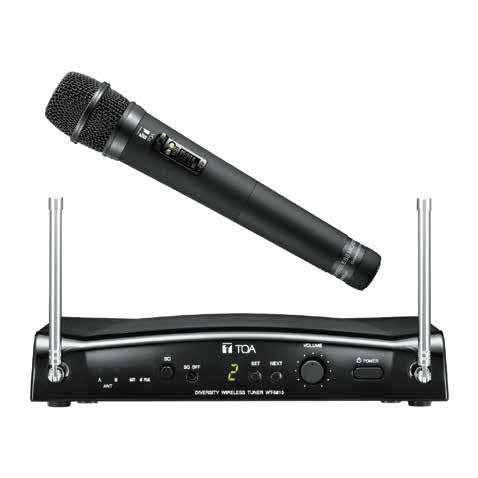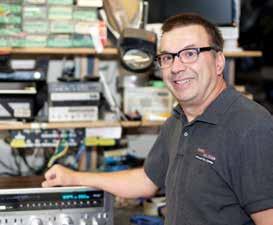
7 minute read
Going wireless: The ABCs of wireless microphones
Up until the 1960s microphones had a cord, which meant the speaker or performer was forced to stay within the limits of the cable.
In the 1970s wireless mic technology became more common and companies like Sennheiser and Nady started putting out single-channel wireless mic systems. The radio frequencies used back then were called VHF. The problem was the VHF units were susceptible to interference from other wireless devices, and some radio frequencies interfered with other ones, causing pops and clicks (and occasional taxi transmissions) to come over the wireless mic system.
Since wireless microphone systems do not require a license to operate, it also leaves each channel wide open to interference from other devices. For example, if a church buys a wireless mic on one frequency, and six months later a house next to the church gets a wireless karaoke system on the same frequency, there’s nothing preventing the systems from interfering with each other.
In the 1990s wireless mics began using UHF, as the VHF frequency band was becoming overcrowded. The UHF frequency bands have far fewer dead spots than VHF systems, and generally have a further range than the older VHF systems did. Most importantly, though, UHF systems are also less prone to interference from other wireless mic systems, allowing for the use of more wireless mic systems in the same room, such as a church, bingo hall or theatrical
We supply, install and service sound and video systems for educational, commercial, and institutional clients across B.C.
From single room audio systems to integrated audio and video systems for an entire complex,
Sound Solutions delivers quality work, on time and on budget. GET IN TOUCH 604-514-1751
Naturally, as everyone switched from VHF to UHF mics, the frequency band also became crowded, and multichannel wireless mics were released at affordable prices. These range from six-channel to 1,500-channel models, allowing users to simply switch to another channel that is interference free. Some models of wireless mics automatically scan the frequency range and set the mic and receiver to a free channel. Diversity systems: Both UHF and VHF mics are available as ‘diversity’ systems. A diversity receiver has two complete receivers in one unit, complete with two antennas, and circuitry in the receiver senses which antenna is picking up the stronger signal from the microphone and automatically switches to that receiver. Of course, diversity systems are a bit more expensive than non-diversity systems. Battery life: Most wireless mics will last eight to 12 hours on one battery. High-end microphones will have additional features such as a battery level indicator on the receiver, so a sound system operator can monitor the battery level at the receiver without touching the transmitter. This is handy both when the system is used for long hours, but also for systems that are rarely used. Portable receivers: Some wireless mic systems are available as portable receivers, handy if you’re going to put the receiver on a floor somewhere to plug into an existing microphone jack, or if event, where multiple wireless mics may be used simultaneously. rack mounted: permanently bolted into a sound rack to prevent 2016-03 OPS Talk Sound Solutions ad copy.pdf 1 2016-03-18 3:55 PM
See us at EFMABC in Penticton May 29 to June 2
THE LEADER IN AUDIO & VIDEO EXCELLENCE FOR OVER 30 YEARS
you are moving the system from place to place. Other receivers are
toll free 1-855-846-0066 info@soundsolutionscanada.com WWW.SOUNDSOLUTIONSCANADA.COM
Although it’s popular to do a “mic drop”, it’s never a good idea to drop the mic as a dented windscreen (as seen here) will affect the sound quality and reliability of your wireless mic.

A 1,000-channel auto-selecting wireless mic system is the best system for sound.


Email: breatheasy2012@gmail.com
Performance Floors and Walls for Schools and Sports
ERV PARENT
Tarkett iQ Vinyl Flooring Tarkett xf2 Linoleum Altro Safety Flooring Mondo Sport Rubber Wall Protection Systems
Erv Parent Co. Ltd. 791 Caldew Street, Delta, BC Tel: 604-525-4142 www.ervparent.com theft. Some receivers come in half-rack sizes allowing you to put two different wireless mic systems side by side in the same rack, saving space.
Good
The basic wireless mic system is a nondiversity VHF system. Good for short-range use and for budget systems, you usually can’t run more than two systems simultaneously in the same area as they will cross interfere. These systems are great for elementary schools. Systems are available with handheld, lapel and headset mics.
Better
A step up from the basic VHF system is a 10- to 20-channel UHF diversity system. Many of the single channel systems have been discontinued over the last few years, as the technology has gone up and pricing has gone down, making 10 channel systems like this one more affordable than ever. A UHF selectable channel system allows you to change frequencies in case of interference, and the range and audio quality is generally better than with an entry-level VHF wireless mic.
Best
A higher-end wireless mic system is a 1,000-channel auto-selecting wireless mic system, with a full-colour receiver display, with features such as transmitter battery life shown right on the receiver face. Some systems are digitally encoded, which means that the transmitter sends a digital code along with the mic audio to the receiver. If the receiver doesn’t receive the digital code, the receiver mutes and does not transmit the audio. This is very useful in mission-critical applications such as theatres, where many wireless mics may be used simultaneously, and also to ensure privacy, as a radio scanner cannot decode the audio signal, even if it is set to the right frequency. This is very important for police and applications where audio privacy is a must.
Wireless mic dos and don’ts:
• Do maintain a line of sight between the transmitter and the wireless mic receiver antennae. While many UHF mic systems will transmit through walls, a concrete wall is an effective barrier to block the wireless mic signals, and even a sheet of drywall or a steel equipment rack can reduce the effective transmission range. • Don’t drop the mic! Mic drops have become popular by entertainers in recent years, but in reality it’s never a good idea to physically abuse your wireless mic! A dented windscreen or cracked transmitter case will affect the sound quality and reliability of your wireless mic. • Don’t use rechargeable batteries. While some wireless mic transmitters are designed for use with rechargeable batteries, a rechargeable battery does not put out the same voltage as a standard alkaline battery, which can reduce range, cause dropouts, or cause short battery life before having to recharge them again. • Don’t go cheap and use ‘no name’ dollar store batteries. These batteries often last only an hour or two in a wireless mic transmitter. Always use a name-brand alkaline battery for longest battery life. • If you use wireless mics on a regular basis, get a battery tester. An inexpensive battery tester with a ‘good/bad’ metre on it will give you a good indication of battery life left, and allow you to get the most life from a disposable battery. • If your wireless mic receiver is mounted in a metal sound-system rack, make sure the antennae are brought to the front of the rack rather than be buried in the back. This will ensure the signal isn’t blocked. Antenna extenders are inexpensive, and will increase the range of your wireless mic.
Sound Solutions carries the Audio Technica, TOA, and Mipro wireless mic lines. Call us and let us help you select the right wireless mic system for your application and budget. Sound Solutions is also one of the very few companies in Canada that owns all of the equipment needed to service today’s wireless mics, including an RF spectrum analyzer. n Curt Palme is owner of Sound Solutions Inc., an audio and video installation and service company serving commercial and institutional clients across B.C.
www.soundsolutionscanada.com

info@soundsolutionscanada.com
facebook.com/SoundSolutions2002Inc
Twitter @soundbc
RCABC — the mark of a quality roofer.

Do you know who is installing your roof?
If they’re RCABC members, then you know they can be trusted. That’s because every member contractor is required to employ Red Seal certified journeypersons who are also required to be on every job site. That’s just one of the strict criteria our organization sets for members, and it’s all a part of our mission to raise the standard of roofing in British Columbia.
Learn more at RCABC.ORG
Ask more from your roofer, ask for an RCABC member.










